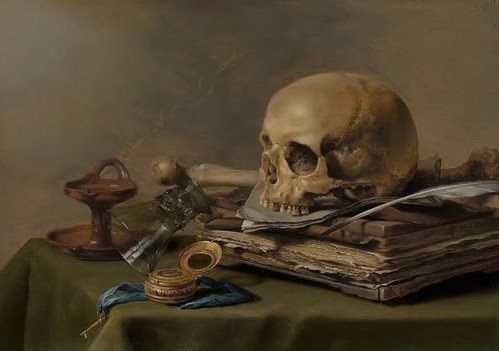Vanitas and All Hallows' Eve
Amid all the gourds and ghouls, the spooky and kooky, the dark and macabre, Christians have differing responses to the annual traditions of this week. However your conscience and convictions lead you to interact (or not) with what has become of October 31, Christians ought to take Halloween most seriously.
I have shared before how I have been helped in considering the missional opportunity the evening’s festivities present, as well as by other resources on the topic. Additionally, the origins of the day incline me to reclaim what has been corrupted. Halloween finds its roots in the Christian observance of Allhallowtide, which comprises “All Hallows’ Eve,” “All Saints’ Day,” and “All Souls’ Day” (read more from Danielle Hitchen). But a significant reason we ought to give serious thought and attention to the day is that the things being trifled with—including the Devil—are absolutely real.
I have shared before how I have been helped in considering the missional opportunity the evening’s festivities present, as well as by other resources on the topic. Additionally, the origins of the day incline me to reclaim what has been corrupted. Halloween finds its roots in the Christian observance of Allhallowtide, which comprises “All Hallows’ Eve,” “All Saints’ Day,” and “All Souls’ Day” (read more from Danielle Hitchen). But a significant reason we ought to give serious thought and attention to the day is that the things being trifled with—including the Devil—are absolutely real.
Playing With Reality
As my family strolls around the neighborhood on evening walks, we see more and more Halloween décor show up in yards as we move deeper into October. There’s the yard with inflatable ghosts, the house with massive spiders, and another with a faux cemetery. My first thought is, “Where do you store all this stuff the rest of the year?” That flutters away quickly to the observation that what is being touted as fun and games is in fact gravely real. Christians too easily default to an anti-supernatural worldview and a simplistic rejection of such things.
Yet the Bible presents a world where witches are real (1 Samuel 28:3-25). Evil giants roam (1 Chronicles 20:6). Ghoulish spirits possess men and animals (Mark 5:1-20). Unseen demonic darkness wages war (Ephesians 6:12). Fortune-tellers, diviners, and necromancers are not mere hucksters and charlatans (Deuteronomy 18:10-12). The creeping things of the earth are fearful (Exodus 8:20-24, 10:3-19). The Devil—Satan himself—prowls about (Job 1:6-12, 1 Peter 5:8). And Death—O Death, that ancient foe—he draws us back into the dust (Genesis 3:19, 1 Corinthians 15:55).
Yet the Bible presents a world where witches are real (1 Samuel 28:3-25). Evil giants roam (1 Chronicles 20:6). Ghoulish spirits possess men and animals (Mark 5:1-20). Unseen demonic darkness wages war (Ephesians 6:12). Fortune-tellers, diviners, and necromancers are not mere hucksters and charlatans (Deuteronomy 18:10-12). The creeping things of the earth are fearful (Exodus 8:20-24, 10:3-19). The Devil—Satan himself—prowls about (Job 1:6-12, 1 Peter 5:8). And Death—O Death, that ancient foe—he draws us back into the dust (Genesis 3:19, 1 Corinthians 15:55).
Two Paths: Triviality or Macabre
All of these things are very real. We ought to take them seriously. Yet our neighbors flirt and flitter around with them every October. It seems to go in one of two directions. The first is to trivialize them—to make blow up cartoon varieties of the Grim Reaper, dress up the seven-year-old as a nondescript demon, and portray silly monsters. The other direction seems to take them more seriously—or at least more darkly. Down that path are the horror movies and the things that make you jump in the dark. Such things tickle the fascination with what really might be at work in our world. Yet engaging with the Darkness in either of those directions fails to take it seriously. The trivial and the macabre both serve to distract. We can dismiss evil spirits, thinking, “Oh, it’s just a silly ghost,” or, “That haunted house was a blast since nothing like that could ever be in the real world.” Either reaction makes light of weighty realities.
Vanitas Art & Memento Mori
One way to arouse our senses—and those of our neighbors—to what is really going on in our world is to reflect on the vanity of it. A genre of classical art that developed in the 1600s is known as Vanitas. That is the Latin word from which we get “vanity,” and it is the driving theme of the book of Ecclesiastes. The art form, like the biblical book, highlights the ephemeral nature of life and the futility of finding deliverance from death and sin in anything of this world. A prominent feature of Vanitas paintings is a human skull, recalling Hamlet’s famous words, “To be or not to be,” spoken while holding a skull. Such artists provoke us to reckon with the world as it really is. Death is real. It is right and wise for us to memento mori—to remember death.

Pieter Claesz, "Vanitas Still Life"
We take death seriously not only because making light of it won’t make it go away, but we take death seriously because we know the Skull Crusher has come (Genesis 3:15, Matthew 27:33). “In him is life, and the life was the light of men. The light shines in the darkness, and the darkness has not overcome it” (John 1:4-5). Christians ought to take Halloween most seriously because it is a day that deals with the most serious of realities. They are the realities that shape and influence this life and the next. And we have been given the privilege of being called children of God, that we might bear witness to the Light that darkness cannot overcome.
